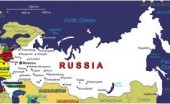Re Ian Bremmer 'Could third-party candidates upend the 2024 US election?' 3 April The current political movement in the USA…
India & China 2010
Written by Diana Thebaud Nicholson // October 5, 2010 // Asia, Economy, Population, Trade & Tariffs // Comments Off on India & China 2010
The Battle of the Billionaires: China Vs. India
(The Globalist) In the world of today, as well as for the foreseeable future, the world’s only population billionaires are China and India — at 1.35 billion and 1.21 billion, respectively. Even so, these two population giants are on distinctly different demographic paths. Joseph Chamie, former director of the United Nations Population Division, explains. See also NYT Dot Earth ‘Population Billionaires’ Face Tough Choices
Chinese dragon versus Indian tiger
Rajeev Sharma: China’s military and diplomatic expansion points to an intensifying arms race between the world’s two most populous countries.
(opendemocracy.net) China’s resurgence in recent years has jolted the leading powers of the world out of their stupor – and India’s case is no different. Today, forward-looking Indian mandarins are no longer obsessed with Pakistan. New Delhi has started developing strategic plans for dealing with China in 2020 or 2030. Many Indian think tanks are already working on this mission objective and those which are not are gearing up to it.
The Chinese infrastructure drive is an integral part of its “string of pearls” strategy vis-a-vis India. Three ports that China is building in India’s immediate neighbourhood – Gwadar in Pakistan, Sittwe in Myanmar and Hambantota in Sri Lanka – are important pearls in the Chinese string. China has a vibrant presence across South Asia. Besides Pakistan, with which China has a true strategic partnership, Beijing has emerged as a major player in Sri Lanka, Bangladesh, Nepal and the Maldives. It has firmly entrenched itself in Myanmar (Burma), Mauritius and the Seychelles.
19 August
(The Economist) Data compiled by Angus Maddison, an economist who died earlier this year, suggest that China and India were the biggest economies in the world for almost all of the past 2000 years. Why they fell so far behind may be more of a mystery than why they are currently flourishing. More
Contest of the century
As China and India rise in tandem, their relationship will shape world politics. Shame they do not get on better
China has officially become the world’s second-biggest economy, overtaking Japan. In the West this has prompted concerns about China overtaking the United States sooner than previously thought. But stand back a little farther, apply a more Asian perspective, and China’s longer-term contest is with that other recovering economic behemoth: India. These two Asian giants, which until 1800 used to make up half the world economy, are not, like Japan and Germany, mere nation states. In terms of size and population, each is a continent—and for all the glittering growth rates, a poor one.
India and China: A Himalayan rivalry
Asia’s two giants are still unsure what to make of each other. But as they grow, they are coming closer—for good and bad
China and India, repositories of 40% of the world’s people, are often unsure what to make of each other. Since re-establishing diplomatic ties in 1976, after a post-war pause, they and their relationship have in many ways been transformed. The 1962 war was an act of Chinese aggression most obviously springing from China’s desire for western Aksai Chin, a lofty plain linking Xinjiang to Tibet. But its deeper causes included a famine in China and economic malaise in both countries. China and India are now the world’s fastest-growing big economies, however, and in a year or two, when India overtakes Japan on a purchasing-power-parity basis, they will be the world’s second- and third-biggest. And as they grow, Asia’s giants have come closer.
Their two-way trade is roaring: only $270m in 1990, it is expected to exceed $60 billion this year. They are also tentatively co-operating, for their mutual enrichment, in other ways: for example, by co-ordinating their bids for the African oil supplies that both rely on. Given their contrasting economic strengths—China’s in manufacturing, India’s in services—some see an opportunity for much deeper co-operation. There is even a word for this vision, “Chindia”. On important international issues, notably climate-change policy and world trade, their alignment is already imposing.
Their leaders naturally talk up these pluses: at the summit of the BRICs (Brazil, Russia, India, China) in Brasília in April, for example, and during celebrations in Beijing earlier this year to commemorate the 60th anniversary of India’s recognition of the People’s Republic. “India and China are not in competition,” India’s sage-like prime minister, Manmohan Singh, often says. “There is enough economic space for us both.”
Forget Chindia
There are many caveats to the recent improvement in their relationship. As the world’s oil wells run dry, many—including sober analysts in both countries—foresee China-India rivalry redrawn as a cut-throat contest for an increasingly scarce resource. The two oil-gluggers’ recent co-operation on energy was, after all, as unusual as it was tentative. More often, Chinese state-backed energy firms compete with all-comers, for Sudanese oil and Burmese gas, and win.
Rivalry over gas supplies is a bigger concern for Indian policymakers. They fear China would be more able to “capture” gas by building massive pipelines overnight. Water is already an object of contention, given that several of the big rivers of north India, including the Brahmaputra, on which millions depend, rise in Tibet. China recently announced that it is building a dam on the Brahmaputra, which it calls the Yarlung Tsangpo, exacerbating an old Indian fear that the Beijing regime means to divert the river’s waters to Chinese farmers.
As for Chindia, it can seem almost too naive to bother about. Over 70% of India’s exports to China by value are raw materials, chiefly iron ore, bespeaking a colonial-style trade relationship that is hugely favourable to China. A proliferating range of Chinese non-tariff barriers to Indian companies, which India grumbles about, is a small part of this. The fault lies chiefly with India’s uncompetitive manufacturing. It is currently cheaper, an Indian businessman says ruefully, to export plastic granules to China and then import them again in bucket-form, than it is to make buckets in India.
Rethinking China’s one-child policy
Thirty years on, some want to scrap the repressive policy. The problem may be to get people to have more—not fewer—babies
(The Economist) Rumblings of discontent over the one-child policy have been growing louder, stirred by debate over whether it is needed now that the first children born under it face the prospect of caring for an ever-increasing number of pensioners. A report last month by the Chinese Academy of Social Sciences (CASS), a leading government think-tank, said officials were seriously overestimating the fertility rate (the number of children an average woman can expect to have in her lifetime). Rather than suppress the rate, suggested the report, the government should try to lift it.



